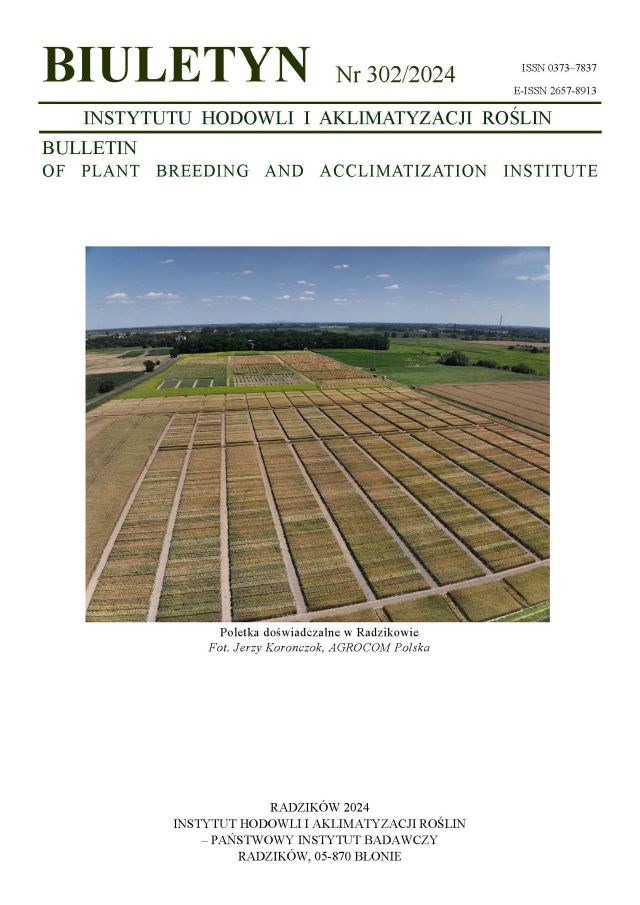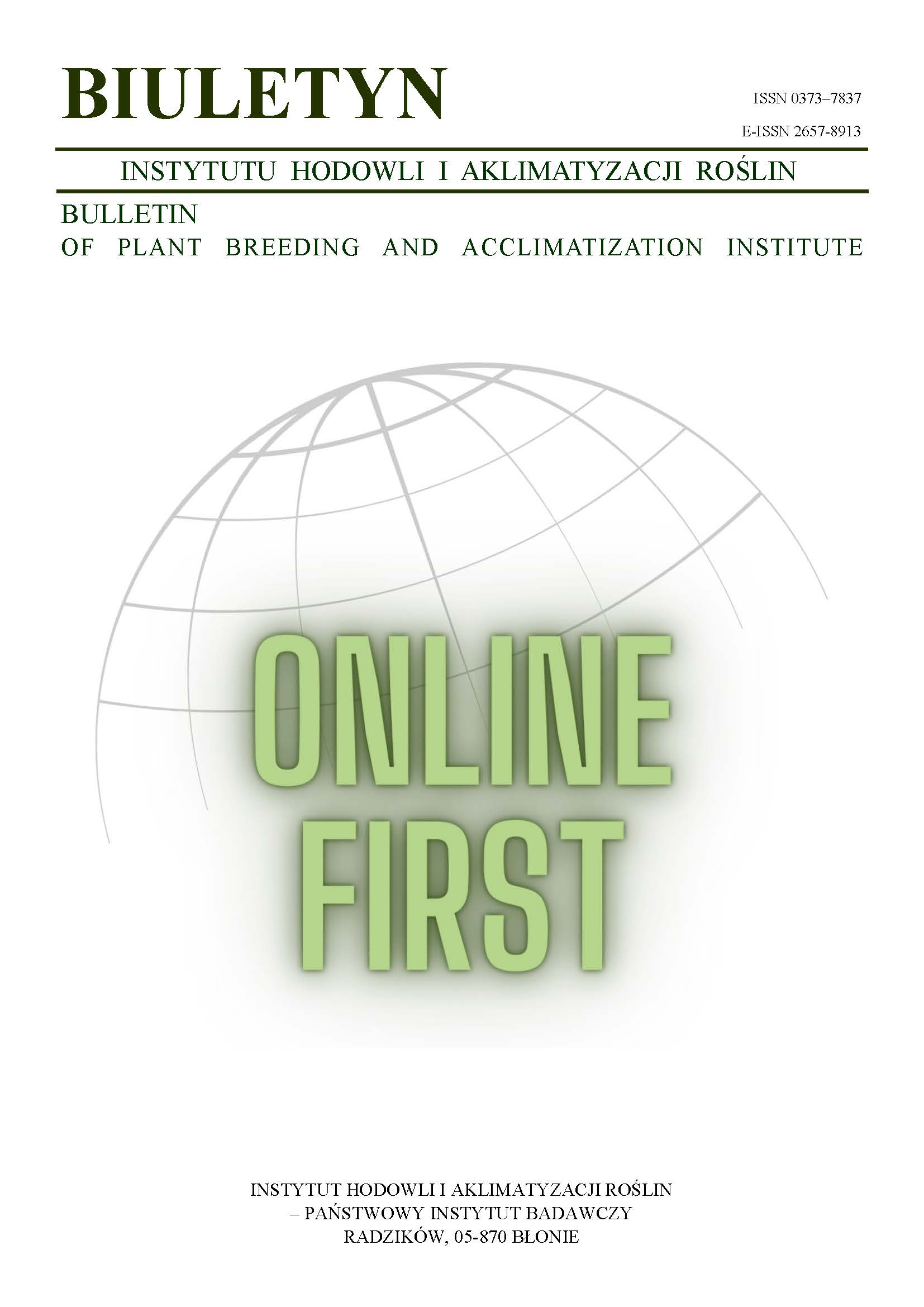Możliwości wykorzystania krzyżowania introgresywnego w hodowli pszenicy ozimej Triticum aestivum L.
Część I. Zastosowanie systemów genetycznych pszenicy T. aestivum L. do otrzymania mieszańców pomostowych F1
Józef Pilch
j.pilch@ihar.edu.plZakład Oceny Jakości i Metod Hodowli Zbóż, Instytut Hodowli i Aklimatyzacji Roślin w Krakowie (Poland)
Abstrakt
Praca przedstawia możliwości wykorzystania krzyżowania introgresywnego dla potrzeb hodowli pszenicy ozimej T. aestivum L. poprzez wytwarzanie materiałów wyjściowych. W części I skoncentrowano się na sposobach zastosowania systemów genetycznych pszenicy homeologicznej/homologicznej koniugacji i krzyżowalności dla uzyskania mieszańców pomostowych, tzw. „F1-bridge” i przełamywania barier krzyżowalności T. aestivum L. z gatunkami rodzajów Triticum, Hordeum, Secale, Aegilops, Agropyron, Lolium. Przedstawiono dostępne źródła genetyczne, metody ich wykorzystania i przydatność w krzyżowaniu introgresywnym ze szczególnym uwzględnieniem genotypów homeologicznej koniugacji Ph1 ph1, ph1b ph1b i krzyżowalności kr1 kr1 kr2 kr2.
Słowa kluczowe:
krzyżowanie introgresywne, mieszańce pomostowe F1, systemy genetyczne, Triticum aestivum L.Bibliografia
Anderson E. 1949. Introgressive hybridization. London, Chapman and Hall.
DOI: https://doi.org/10.5962/bhl.title.4553
Google Scholar
Chapman V., Miller T. E. 1981. The location of a gene affecting meiotic chromosome pairing at low temperature in Triticum aestivum. Z. Pflanzenzüchtg. 86: 50 — 55.
Google Scholar
Chen P.D.,Tsujimoto H., Gill B.S. 1994. Transfer of Ph I genes promoting homoeologous pairing from Triticum speltoides to common wheat. Theor. Appl. Genet. 88: 97 — 101.
DOI: https://doi.org/10.1007/BF00222400
Google Scholar
Dhaliwal H. S. 1977. The Ph gene and the origin of tetraploid wheats. Genetica, 47, 3: 177 — 182.
DOI: https://doi.org/10.1007/BF00123238
Google Scholar
Dover G. A., Riley R. 1972. Prevention of pairing of homoeologous meiotic chromosomes of wheat by an activity of supernumerary chromosomes of Aegilops. Nature 240: 159 — 161.
DOI: https://doi.org/10.1038/240159a0
Google Scholar
Driscoll C. 1972. Genetic suppression of homoeologous pairing in hexaploid wheat. Can. J. Genet. Cytol. 14: 39 — 42.
DOI: https://doi.org/10.1139/g72-004
Google Scholar
Driscoll C. J., Jensen N. F. 1963. A genetic method for detecting induced intergeneric translocations. Genetics 48: 459 — 468.
DOI: https://doi.org/10.1093/genetics/48.4.459
Google Scholar
Dvorak J., Chen K. C., Giorgi B. 1984. The C-banding pattern of a Ph-mutant of durum wheat. Can. J. Genet. Cytol. 26: 360 — 363.
DOI: https://doi.org/10.1139/g84-056
Google Scholar
Evans G. M., Macefield A. J. 1973. The effect of B chromosomes on homoeologous pairing in species hybrids. 1. Lolium temulentum × Lolium perenne. Chromosoma 41: 63 — 73.
DOI: https://doi.org/10.1007/BF00284074
Google Scholar
Fedak G., Jui P.Y. 1982. Chromosomes of Chinese Spring wheat carrying genes for crossability with Betzes barley. Can. J.Genet. Cytol. 24: 227 — 233.
DOI: https://doi.org/10.1139/g82-024
Google Scholar
Feldman M. 1966. The effect of chromosomes 5B, 5D and 5A on chromosomal pairing in Triticum aestivum. Proc. Nat. Acad Sci. USA 55: 1447 — 1453.
DOI: https://doi.org/10.1073/pnas.55.6.1447
Google Scholar
Giorgi B. 1978. A homoeologous pairing mutant isolated in T. durum cv. “Cappelli”. Mutat. Breed. Newsl. 11: 4 — 5.
Google Scholar
Hayter A. M., Riley R. 1967. Duplicate genetic activities affecting meiotic chromosome pairing at low temperatures in Triticum. Nature 216, No. 5119: 1028 — 1029.
DOI: https://doi.org/10.1038/2161028a0
Google Scholar
Kimber G. 1967. The incorporation of the resistance of Aegilops ventricosa to Cercosporella herpotrichoides into Triticum aestivum. J. Agric. Sci. Camb. 68: 373 — 376.
DOI: https://doi.org/10.1017/S0021859600012879
Google Scholar
Kluska T., Pilch J. 1995. Krzyżowanie odmian i rodów pszenicy heksaploidalnej Triticum aestivum L. z żytem diploidalnym Secale cereale L. i uzyskanie form pierwotnych pszenżyta oktoploidalnego. Biul. IHAR 194: 53 — 61.
Google Scholar
Krolow K. D. 1970. Untersuchungen über die Kreuzbarkeit zwischen Weizen und Roggen. Z. Pflanzenzüchtg. 64: 44 — 72.
Google Scholar
Lein A. 1943. Die genetische Grundlage der Kreuzbarkeit zwischen Weizen und Roggen. Z. Vererbungsl. 81: 28 — 61.
DOI: https://doi.org/10.1007/BF01847441
Google Scholar
Lelley T. 1976. The effect of supernumerary chromosomes of rye on homoeologous pairing in hexaploid wheat. Z. Pflanzenzüchtg. 77: 281 — 285.
Google Scholar
Luo M. C., Yen C., Yang J. L. 1992. Crossability percentage of bread wheat landraces from Sichuan province China with rye. Euphytica 61: 1 — 7.
DOI: https://doi.org/10.1007/BF00035540
Google Scholar
Luo M. C., Yen C., Yang J. L. 1993. Crossability percentages of bread wheat landraces from Shaanxi and Henan provinces, China with rye. Euphytica 67: 1 — 8.
DOI: https://doi.org/10.1007/BF00022718
Google Scholar
Mello-Sampayo T. 1971. Genetic regulation of meiotic chromosome pairing by chromosome 3D of Triticum aestivum. Nature New Biol. 230: 22 — 23.
DOI: https://doi.org/10.1038/newbio230022a0
Google Scholar
Pilch J. 1996. Performance of interspecific and intergeneric hybrids of Triticum aestivum L for wheat improvement. Part I. Performance of winter generations F3 — F5 of T. aestivum L. with Triticum {2x, 4x}, Aegilops {2x}, and Elymus {4x} species in respect of some characters of spike. Plant Breed. Seed Sci., vol. 40, No. 3/4: 73 — 62.
Google Scholar
Pilch J., Głowacz E. 1997. Międzygatunkowe i międzyrodzajowe krzyżowania jako sposób ulepszania cech kłosa w hodowli pszenicy heksaploidalnej Triticum aestivum L. Biul. IHAR 204: 15 — 31.
Google Scholar
Pilch J. 2001. Crossability effects of spring wheat (Triticum durum Desf.) with rye (Secale cereale L.) genotypes. Plant Breeding Seed Sci. vol. 45. No. 2: 33 — 43.
Google Scholar
Pilch J. 2002 a. Wartość technologiczna introgresywnych form pszenicy ozimej (Triticum aestivum L.). Biul. IHAR 223/224: 95 — 109.
Google Scholar
Pilch J. 2002 b. Transformacje cech kłosa pszenicy Triticum aestivum L. z wykorzystaniem międzygatunkowej i międzyrodzajowej hybrydyzacji.. Zesz. Probl. Post. Nauk Rol., zesz. 488: 207 — 213.
Google Scholar
Pilch J. 2004. Wykorzystanie hybrydyzacji introgresywnej w podwyższaniu wartości technologicznej ziarna pszenicy ozimej Triticum aestivum L. Pam. Puł. 135: 247 — 257.
Google Scholar
Qu L. J., Foote T. N., Roberts M. A., Money T. A., Aragon-Alcaide L., Snape J. W., Moore G. 1998. A simple PCR-based method for scoring the ph1b deletion in wheat. Theor. Appl. Genet. 96: 376 — 375.
DOI: https://doi.org/10.1007/s001220050751
Google Scholar
Riley R., Chapman V. 1958. Genetic control of the cytologically diploid behavior of hexaploid wheat. Nature 182: 713 — 715.
DOI: https://doi.org/10.1038/182713a0
Google Scholar
Riley R. 1960. The diploidization of polyploid wheat. Heredity 15: 407 — 429.
DOI: https://doi.org/10.1038/hdy.1960.106
Google Scholar
Riley R. 1966. The genetic regulation of meiotic behavior in wheat and its relatives. In: MacKay J. (ed.) Proc. 2nd Int. Wheat Genet. Symp. Hereditas 2 (Suppl): 395 — 408.
Google Scholar
Riley R., Chapman V. 1967. The inheritance in wheat of crossability with rye. Genet. Res. 9: 259 — 267.
DOI: https://doi.org/10.1017/S0016672300010569
Google Scholar
Riley R., Kimber G., Chapman V. 1961. Origin of genetic control of diploid-like behavior of polyploid wheat. J. Hered. 52: 22 — 25.
DOI: https://doi.org/10.1093/oxfordjournals.jhered.a107015
Google Scholar
Riley R., Chapman V., Miller T. E. 1973. The determination of meiotic chromosome pairing. Proc. 4th Int. Wheat Genet. Symp. Univ. Columbia. MO.: 731 — 738.
Google Scholar
Romero C., Lacadena J. R. 1980. Interaction between rye B-chromosomes and wheat genetic systems controlling homoeologous pairing. Chromosom (Berl.) 80: 33 — 48.
DOI: https://doi.org/10.1007/BF00327564
Google Scholar
Sears E. R. 1954. The systematic, cytology and genetics of wheat. Res. Bull. Mis. Agric. Exptl. Stat. 572: 1 — 58.
Google Scholar
Sears E. R. 1956. The transfer of leaf-rust resistance from Aegilops umbellulata to wheat. Brookhaven Symposia in Biology 9: 1 — 22.
Google Scholar
Sears E. R. 1976. Genetic control of chromosome pairing in wheat. Ann. Rev. Genet.10: 31 — 51.
DOI: https://doi.org/10.1146/annurev.ge.10.120176.000335
Google Scholar
Sears E. R. 1977. An induced mutant with homoeologous pairing in common wheat. Can. J. Genet. Cytol. 19: 585 — 593.
DOI: https://doi.org/10.1139/g77-063
Google Scholar
Sears E. R. 1981. Transfer of alien genetic material to wheat. In: Evans IT, Peacock WI (eds.) Wheat science — today and tomorrow. Cambridge Univ. Press.UK: 75 — 89.
Google Scholar
Sears E. R. 1982. A wheat mutation conditioning an intermediate level of homoeologous chromosome pairing. Can. J. Genet. Cytol. 24: 715 — 719.
DOI: https://doi.org/10.1139/g82-076
Google Scholar
Sears E. R. 1984. Mutations in wheat that raise the level of meiotic chromosome pairing. In: Gene manipulation in plant improvement. Stadler Genet. Symp., 16th. Plenum Press, New York (Ed. Gustafson J. P.): 295 — 300.
DOI: https://doi.org/10.1007/978-1-4613-2429-4_11
Google Scholar
Segal G., Liu B., Vega J. M., Abbo S., Rodova M., Feldman M. 1977. Identification of a chromosome-specific probe that maps within the Ph1 deletions in common and durum wheat. Theor. Appl. Genet. 94: 968 — 970.
DOI: https://doi.org/10.1007/s001220050502
Google Scholar
Xie D. X., Devos K. M., Moore G., Gale M. D. 1993. RFLP-based genetic maps of the homoeologous group 5 chromosomes of bread wheat (Triticum aestivum L.). Theor. Appl. Genet. 87: 70 — 74.
DOI: https://doi.org/10.1007/BF00223747
Google Scholar
Autorzy
Józef Pilchj.pilch@ihar.edu.pl
Zakład Oceny Jakości i Metod Hodowli Zbóż, Instytut Hodowli i Aklimatyzacji Roślin w Krakowie Poland
Statystyki
Abstract views: 62PDF downloads: 28
Licencja
Prawa autorskie (c) 2005 Józef Pilch

Utwór dostępny jest na licencji Creative Commons Uznanie autorstwa – Na tych samych warunkach 4.0 Miedzynarodowe.
Z chwilą przekazania artykułu, Autorzy udzielają Wydawcy niewyłącznej i nieodpłatnej licencji na korzystanie z artykułu przez czas nieokreślony na terytorium całego świata na następujących polach eksploatacji:
- Wytwarzanie i zwielokrotnianie określoną techniką egzemplarzy artykułu, w tym techniką drukarską oraz techniką cyfrową.
- Wprowadzanie do obrotu, użyczenie lub najem oryginału albo egzemplarzy artykułu.
- Publiczne wykonanie, wystawienie, wyświetlenie, odtworzenie oraz nadawanie i reemitowanie, a także publiczne udostępnianie artykułu w taki sposób, aby każdy mógł mieć do niego dostęp w miejscu i w czasie przez siebie wybranym.
- Włączenie artykułu w skład utworu zbiorowego.
- Wprowadzanie artykułu w postaci elektronicznej na platformy elektroniczne lub inne wprowadzanie artykułu w postaci elektronicznej do Internetu, lub innej sieci.
- Rozpowszechnianie artykułu w postaci elektronicznej w internecie lub innej sieci, w pracy zbiorowej jak również samodzielnie.
- Udostępnianie artykułu w wersji elektronicznej w taki sposób, by każdy mógł mieć do niego dostęp w miejscu i czasie przez siebie wybranym, w szczególności za pośrednictwem Internetu.
Autorzy poprzez przesłanie wniosku o publikację:
- Wyrażają zgodę na publikację artykułu w czasopiśmie,
- Wyrażają zgodę na nadanie publikacji DOI (Digital Object Identifier),
- Zobowiązują się do przestrzegania kodeksu etycznego wydawnictwa zgodnego z wytycznymi Komitetu do spraw Etyki Publikacyjnej COPE (ang. Committee on Publication Ethics), (http://ihar.edu.pl/biblioteka_i_wydawnictwa.php),
- Wyrażają zgodę na udostępniane artykułu w formie elektronicznej na mocy licencji CC BY-SA 4.0, w otwartym dostępie (open access),
- Wyrażają zgodę na wysyłanie metadanych artykułu do komercyjnych i niekomercyjnych baz danych indeksujących czasopisma.
Inne teksty tego samego autora
- Józef Pilch, Efektywność introgresji genów Glu-1 wysokocząsteczkowych glutenin w zwiększaniu wartości wypiekowej ziarna zbóż — przegląd literatury , Biuletyn Instytutu Hodowli i Aklimatyzacji Roślin: Nr 243 (2007): Wydanie regularne
- Józef Pilch, Introgresje genów z gatunków spokrewnionych taksonomicznie w ulepszeniach pszenicy Triticum aestivum L. i innych roślin uprawnych , Biuletyn Instytutu Hodowli i Aklimatyzacji Roślin: Nr 260/261 (2011): Wydanie regularne
- Józef Pilch, Wykorzystanie genów z gatunków diploidalnych, tetraploidalnych i heksaploidalnych pszenicy Triticum L. w odmianach pszenicy heksaploidalnej Triticum aestivum L. , Biuletyn Instytutu Hodowli i Aklimatyzacji Roślin: Nr 262 (2011): Wydanie regularne
- Józef Pilch, Genetyczne możliwości ulepszania jakości ziarna pszenicy ozimej Triticum aestivum L. w efekcie hybrydyzacji introgresywnej z Triticum durum Desf. , Biuletyn Instytutu Hodowli i Aklimatyzacji Roślin: Nr 236 (2005): Wydanie regularne
- Józef Pilch, Wpływ genomów A, B Triticum durum Desf. na wartość technologiczną ziarna pszenicy ozimej Triticum aestivum L. , Biuletyn Instytutu Hodowli i Aklimatyzacji Roślin: Nr 230 (2003): Wydanie regularne
- Józef Pilch, Uwarunkowania genetyczne cech morfologicznych kłosa pszenicy (Triticum aestivum L.) , Biuletyn Instytutu Hodowli i Aklimatyzacji Roślin: Nr 228 (2003): Wydanie regularne
- Józef Pilch, Możliwości wykorzystania krzyżowania introgresywnego w hodowli pszenicy ozimej Triticum aestivum L. , Biuletyn Instytutu Hodowli i Aklimatyzacji Roślin: Nr 235 (2005): Wydanie regularne














